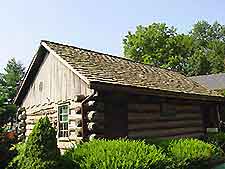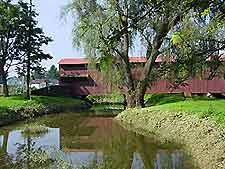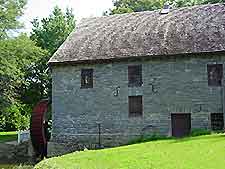Lancaster History Facts and Timeline
(Lancaster, Pennsylvania - PA, USA)

Lancaster boasts an interesting history. This Pennsylvania town officially became a townstead in the year 1734, after the settlement was planned and laid out by James Hamilton, the son of Andrew Hamilton, who owned most of the land around the area. James Hamilton designed the town in a rectangular format, with straight streets built around a town square.
Originally, the town was named Hickory Town, but the name was later changed by local John Wright to Lancaster (after the city in
England). This is where the town gets its current nickname, the Red Rose City.
Capital of the Colonies
The city grew in stature to become one of the most important inland settlements within the original 13 colonies of America. A large prison was built in the 1730s, which can still be seen and toured today. It was constructed to match the design of England's Lancaster Castle. Much of the history of Lancaster was influenced by the American Revolution. In 1777, when the British took control of the congress convening point of
Philadelphia, congress moved here.

Post Revolutionary Growth and History
The city experienced strong growth following the end of the American Revolutionary War, especially after America's first paved road was built between Philadelphia and Lancaster. It was called the Philadelphia-Lancaster Turnpike and is now part of the US Route 30 highway. The railroad also contributed to the development of Lancaster during this time. Today, just outside of the city, the Railroad Museum of Pennsylvania in the neighboring borough of Strasburg can be visited for insight into the railway's significance.
German religious refugees began to settle on farms around Lancaster in the 1700s, due to the city's accepting stance on religion. Descendants of these refugees, known as the Amish, still live in the area and have become something of a tourist attraction. The Amish live a basic lifestyle, with no electricity and rarely any modern comforts to this day.
Post American Revolution, Lancaster became a significant iron-foundry hub, with iron the main economic source for the area. The city produced the Conestoga Wagon, which was used for transport prior to the construction of railroads, as well as manufacturing the famous Pennsylvania rifle.

Influential Residents
The history of Lancaster is colored by its many famous residents. The 15th President of the Unites States, James Buchanan, was a long time resident of the city. Tourists can still visit Wheatland, which is the former president's famous estate.
Robert Fulton, who was the first person to design and construct steamboats, lived in Lancaster during the 18th century. In 1879, Franklin Woolworth began to operate his famous 'five and dime' store, which grew into an enormous chain throughout the United States.
Modern-Day and Economy
The modern city of today continues to preserve its rich and intriguing heritage. Tourists from all over the United States regularly visit the city, which now relies heavily on tourism for its economy.
Tours of the city usually begin at the famous Central Market Center and travel through the many historic sites of downtown Lancaster.
 Lancaster boasts an interesting history. This Pennsylvania town officially became a townstead in the year 1734, after the settlement was planned and laid out by James Hamilton, the son of Andrew Hamilton, who owned most of the land around the area. James Hamilton designed the town in a rectangular format, with straight streets built around a town square.
Lancaster boasts an interesting history. This Pennsylvania town officially became a townstead in the year 1734, after the settlement was planned and laid out by James Hamilton, the son of Andrew Hamilton, who owned most of the land around the area. James Hamilton designed the town in a rectangular format, with straight streets built around a town square.
